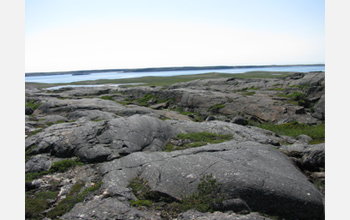All Images


Press Release 08-165
Oldest Known Rock on Earth Discovered

Bedrock in Canada is 4.28 billion years old
Back to article | Note about images
 |
Bedrock along the northeast coast of Hudson Bay, Canada, has the oldest rock on Earth.
Credit: Jonathan O'Neil |
Download the high-resolution JPG version of the image. (3.6 MB)
|
Use your mouse to right-click (or Ctrl-click on a Mac) the link above and choose the option that will save the file or target to your computer.
|
 |
Earth's oldest known rock is composed of the mineral amphibole, which contains abundant garnet, seen as large round "spots" in the rock.
Credit: Jonathan O'Neil |
Download the high-resolution JPG version of the image. (6.5 MB)
|
Use your mouse to right-click (or Ctrl-click on a Mac) the link above and choose the option that will save the file or target to your computer.
|
 |
The findings are published in this week's issue of Science magazine.
Credit: Copyright AAAS 2008 |
Download the high-resolution JPG version of the image. (1.1 MB)
|
Use your mouse to right-click (or Ctrl-click on a Mac) the link above and choose the option that will save the file or target to your computer.
|
|





